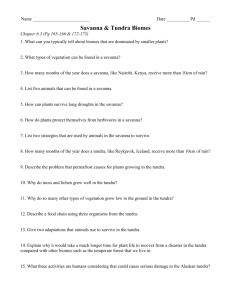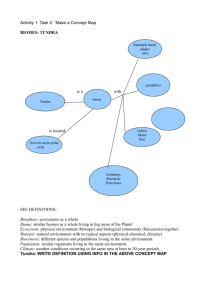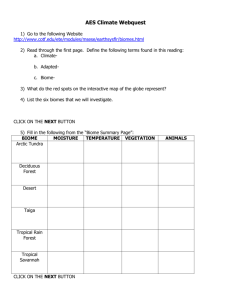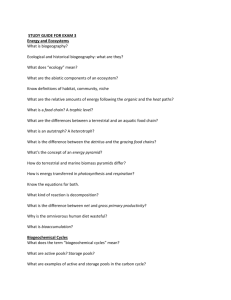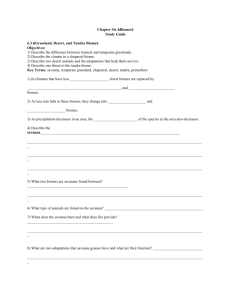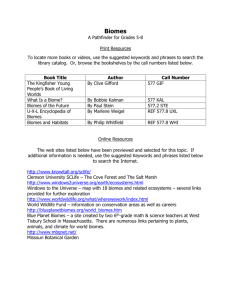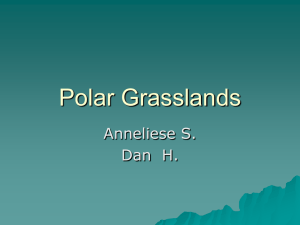HUMANITY & THE WORLD BIOMES Unit 2-2a The Tundra
advertisement
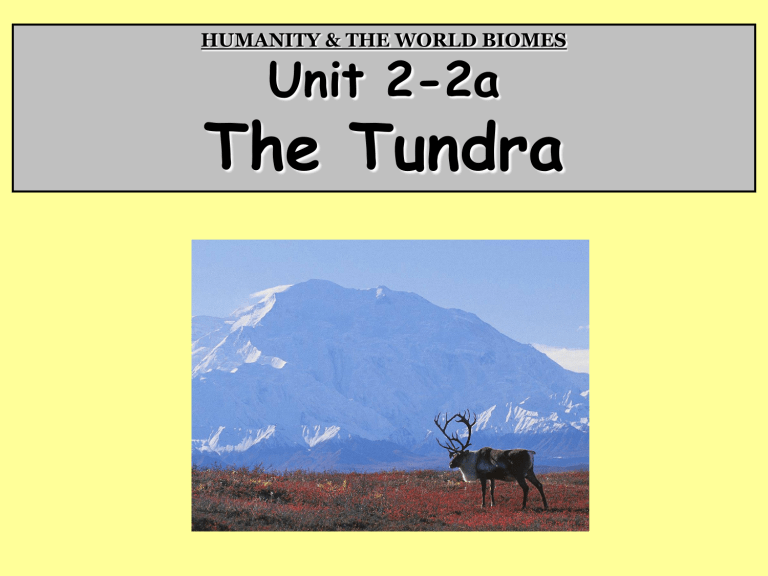
HUMANITY & THE WORLD BIOMES Unit 2-2a The Tundra Characteristics Of The Tundra Tundra Temperature Precipitation Biodiversity Low Low Low Locations – Tundra can be found at both poles and at the top of the tallest mountains. Abiotic Factors • Temperatures range from just above freezing in the summer to -50oF in the winter. • In the summer, the top of the permanently frozen soil called permafrost thaws to create some moisture during the short growing season. What’s It Like In Barrow, Alaska? Imagine the Earth rotating… Would the north pole get any sunlight? When the Earth’s axis is tilted away from the sun it is winter & there are 30 days of night at the pole. But in the summer, with the axis tilted toward the sun, there are 30 days of sunlight! Tundra Plants Because the tundra is covered in ice, these plants must survive without deep soil and very little moisture. Dwarf Willow – World’s smallest tree (~3 in tall) hides from strong winds Moss Campion – Flower very quickly and have short hairs on their leaves for insulation Lichen – A composite organism of a producer & a fungus that can grow on solid rock Why aren’t there any evergreen trees in the tundra? Tundra Animals How do animals survive the extreme conditions of the tundra? Arctic Fox – The short legs, ears & muzzle help conserve heat; It’s fur changes color with the seasons. Caribou – Have large hooves that support them in marshes & snow; Shorter legs & seasonal fur color. Polar Bear – Has dark skin and clear fur to absorb the sun’s rays; Thick blubber & webbed feet to swim. Penguin – Black & white color for camouflage while swimming underwater. Do all of these animals share a common adaptation? Close Your Notebooks… What have you learned in this unit? 1. Describe the temp, precipitation and biodiversity of the tundra. 2. Where are tundra located? 3. How many hours of daylight does the tundra receive during each season? 4. What adaptations have plants developed to live in permafrost? 5. Name two animal adaptations for the tundra. HUMANITY & THE WORLD BIOMES Unit 2-2b The Savanna Characteristics Of The Savanna Savanna Temperature Precipitation Biodiversity High Average Average Locations – Savannas are tropical grasslands located near the equator in Africa, India, Australia & South America. Abiotic Factors • Temperatures average between 80-90oF all year. There are two seasons – wet & dry. • While most of the year is dry, the wet season brings monsoons with ~20 inches of heavy rains. How Is The Savanna Maintained? Grasses dominate the savanna because… • Grazing animals eat significantly each day, • Droughts are common and, • Naturally-occurring fires are frequent And these factors prevent larger plants from growing Forests generally need at least 55 inches of rain/year Savanna Plants Bermuda Grass – Has a deep root system that stores water during droughts and helps it re-grow after fires. Elephant Grass – Can grow 10 ft tall with razor-sharp blades. Senegal Gum – A thorny tree with sap that makes several medicines Candelabra Tree – Has a sticky, poisonous sap that causes blisters Which two survival strategies are used by these plants? Savanna Animals Due to droughts, savanna animals have strong and/or long legs to support migration over great distances. African Elephant – Long trunk for reaching; Large, thin ears that wave to dissipate heat. Zebra – Stripes to confuse predators; Thick hooves for defensive kicking Wild Dog – Large ears; Strong legs; Multicolored camouflage coat Kangaroo – Pouch for developing young; Powerful legs for jumping Do all of these animals share a common adaptation? Close Your Notebooks… What have you learned in this unit? 1. Describe the temp, precipitation and biodiversity of the savanna. 2. Where are savannas located? 3. Which three factors prevent grasslands from becoming forests? 4. List two plant adaptations for the savanna. 5. List two animal adaptations for the savanna. HUMANITY & THE WORLD BIOMES Unit 2-2c Integumentary Adaptations To Extreme Biomes The Integumentary System Comprised of hair, nails & skin Hair & Nails - Protection & insulation. Made from mostly keratin which makes cells tough & waterproof. Skin - Protection from infection, injury & dehydration; Maintains body temperature. • Epidermis - Outer layer of skin; Dead, flat cells of keratin. • Dermis - Lined with nerve cells, hair follicles, sweat glands and blood vessels. • Subcutaneous Layer - Deepest layer of fatty tissue that insulates, cushions & stores nutrients. Look At These People Which parts of the integumentary system are visible? Skin Hair Nails The Eyes What can you see that is not part of the integumentary system? Shades of Skin Color Melanin – A pigment created by the inner layer of the epidermis that protects the skin from UV radiation. Higher levels of melanin, producing darker skin, offer more protection from the sun’s rays. Lower levels of melanin, producing lighter skin, allow for increased production of Vitamin D. Albino people cannot produce pigment. Von Luschan’s Chromatic Scale 1 5 10 15 20 25 30 36 Integumentary System Diseases Skin Cancer – A genetic mutation that’s caused by overexposure to UV radiation. The ABCD’s of skin cancer not uniform Carcinomas – A more common condition affecting nonpigment producing cells. It can be successfully treated. Melanomas – A more rare cancer affecting pigment producing cells that spread quickly and accounts for the majority of skin cancer deaths. Other Skin Adaptations The average core body temperature is about 98.6°F, To prevent hypothermia (<94°F) in extreme cold… • The skin shivers creating warmth by muscle movement • Goosebumps make hairs stand up to trap warm air • Blood flow to the extremities (includes fingers, toes, ears & nose) reduces to preserve core body temperature What’s this called? Other Skin Adaptations To prevent hyperthermia (>105°F) in extreme heat… • The skin sweats, cooling the body as it evaporates • Blood flow to the extremities increases, releasing heat from the body • In serious cases, the body reduces urination & sweating Close Your Notebooks… What have you learned in this unit? 1. What three parts of the body make up the integumentary system? 2. What is the name & function for each layer of our skin? 3. What are the results of higher and lower levels of melanin? 4. Explain how a person can get skin cancer & the symptoms of it. 5. How does our skin react to extreme temperatures in order to regulate body temperature? Dust Mite & Dead Skin HUMANITY & THE WORLD BIOMES Unit 2-2d Musculoskeletal Adaptations To Extreme Biomes The Skeletal System There are 206 bones in an adult (350 in an infant) that provides protection, gives us shape & enables movement. The skeleton is divided into… • Axial – Makes up the skull and trunk • Appendicular – Makes up the limbs A Joint, where two bones meet, functions due to… • Ligaments – Hold two bones together • Tendons – Attach muscle to the bone What is the purpose of the cartilage? Skeletal System Diseases Osteoporosis – Porous and brittle bones in people Can be prevented through proper nutrition. Arthritis – Diseases that wear away cartilage causing painful bone on bone contact. Leukemia – Blood cancer in which an overabundance of defective blood cells are formed in the bone marrow Calcium absorption reduces dramatically after age 35 so… Start Building Strong Bones Today! How Do Muscles Your Arm Move? Muscles always work together in pairs. Each pull in opposite directions to create movement. Which muscles contract to open & close your arm? Extensor - A muscle that opens a joint. Flexor – A muscle that closes a joint. Identify these… Joint Extensor Flexor Elbow Triceps Biceps These muscles create motion in all parts of your body including your wrist, jaw, neck, and even eyelids. Musculoskeletal Adaptations People native to polar biomes generally have… • Stockier bodies with shorter limbs • Higher percentage of body fat • Flatter faces without extruding features How do these strategies help people survive in polar biomes? Musculoskeletal Adaptations People native to tropical biomes generally have… • Taller, slender bodies • Carry very little fat How do these strategies help people survive in tropical biomes? Close Your Notebooks… What have you learned in this unit? 1. Why do babies have so many more bones than adults? 2. Name one bone in both the axial and the appendicular skeleton. 3. What steps can you take to reduce the risk of bone disease? 4. Estimate how many different muscles control your neck motion. 5. Describe the most successful body types for surviving at the poles & the equator.
